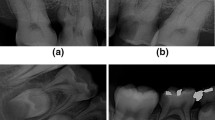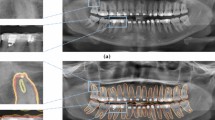Abstract
In the field of dental image processing and analysis, automatic segmentation results of dental hard tissue can provide a useful reference for the clinical diagnosis and treatment process. However, the segmentation accuracy is greatly affected due to the limitation of imaging conditions in the oral environment, as well as the complexity of dental hard tissue topology. To further improve the precision of dental hard tissue segmentation, a novel algorithm was presented by using the sparse representation-based classifier and mathematical morphology operations. First, the captured dental image was preprocessed to eliminate the impact of imbalance local illumination. Then, the preliminary dental hard tissue areas were calculated as the initial marker regions based on color characteristics analysis, and the sparse representation-based classifier was applied sequentially to optimize the initial marker regions combined with certain morphological operations. Finally, a modified marker-controlled watershed transform was employed to segment dental hard tissue regions on the basis of the optimized marker regions, and the final results were obtained after homogeneous region merging. The experimental results show that our method has better adaptability and robustness than existing state-of-the-art methods.

Graphical abstract










Similar content being viewed by others
References
Rad AE, Rahim MS, Rehman A (eds) (2013) Evaluation of current dental radiographs segmentation approaches in computeraided applications. IETE Tech Rev 30(3):210–222
Michetti J, Georgelingurgel M, Mallet JP (eds) (2015) Influence of CBCT parameters on the output of an automatic edge-detection-based endodontic segmentation. Dentomaxillofac Radiol 44(8):20140413
Razali MRM, Ahmad NS, Hassan R (eds) (2014) Sobel and canny edges segmentations for the dental age assessment. International Conference on Computer Assisted System in Health p 62–66
Michetti J, Basarab A, Diemer F (eds) (2017) Comparison of an adaptive local thresholding method on CBCT and μCT endodontic images. Phys Med Biol 63(1):015020
Shan DR, Gao FY 2010 The segmentation algorithm of dental CT images based on fuzzy maximum entropy and region growing. International Conference on Bioinformatics and Biomedical Technology p 74–78
Arifin AZ, Indraswari R, Suciati N (eds) (2017) Region merging strategy using statistical analysis for interactive image segmentation on dental panoramic radiographs. International Review on Computers & Software 12(1):63
Setianingrum AH, Rini AS, Hakiem N eds. 2017. Image segmentation using the Otsu method in dental X-rays. International Conference on Informatics & Computing Biology p 1–6
Lai YH, Lin PL 2008. Effective segmentation for dental X-ray images using texture-based fuzzy inference system. Advanced concepts for intelligent vision systems p 936–947
Harma N, Aggarwal LM (2010) Automated medical image segmentation techniques. J Med Phys 35(1):3–14
Li H, Sun G, Sun H (eds) (2013) Watershed algorithm based on morphology for dental X-ray images segmentation. IEEE International Conference on Signal Processing p 877–880
Hussain S, Qi C, Asif MR, eds. 2016. A novel trigonometric energy functional for image segmentation in the presence of intensity in-homogeneity. IEEE international conference on multimedia and expo p 1–6
Sepehrian M, Deylami AM, Zoroofi RA (2016) Individual teeth segmentation in CBCT and MSCT dental images using watershed. Biomed Eng p 1–6
Tam WK, Lee HJ (2016) Improving tooth outline detection by active appearance model with intensity-diversification in intraoral radiographs. J Inf Sci Eng 32(3):643–659
Kronfeld T, Brunner D, Brunnett G (2010) Snake-based segmentation of teeth from virtual dental casts. Comput-Aided Des Applic 7(2):221–233
Pandey P, Bhan A, Dutta MK 2017 Automatic image processing based dental image analysis using automatic Gaussian fitting energy and level sets. International Conference and Workshop on Bioinspired Intelligence p 1–5
Pavaloiu IB, Goga N 2015 Neural network based edge detection for CBCT segmentation. E-Health and Bioengineering Conference p 1–4
Shimizu T, Tokumori K, Yoshiura K (2004) Automatic extraction of the tooth outline on the intra-oral radiograph using wavelet transforms. Shika Hoshasen 44:161–168
Streso K, Lagona F 2005 Hidden markov random field and frame modelling for TCA-image analysis. Mpidr Working Papers
Le HS, Tuan TM (2016) A cooperative semi-supervised fuzzy clustering framework for dental x-ray image segmentation. Expert Syst Appl 46:380–393
Prakash M, Gowsika U, eds. 2015. An identification of abnormalities in dental with support vector machine using image processing. Emerging Research in Computing, Information, Communication and Applications. Springer India p 29–40
He H, He M, Han JVT, eds. 2017 Automatic detection of neovascularization in retinal images using extreme learning machine. Neurocomputing 277:218-227
Maduskar P, Philipsen RH, Melendez J (eds) (2016) Automatic detection of pleural effusion in chest radiographs. Med Image Anal 28:29–40
Belghith A, Balasubramanian M, Bowd C (2013) A unified framework for glaucoma progression detection using Heidelberg retina tomograph images. Comput Med Imaging Graph 4(9):411–420
Wright J, Yang AY, Ganesh A (eds) (2008) Robust face recognition via sparse representation. IEEE Trans Pattern Anal Mach Intell 31(2):210–227
Xi J, Wei W (2018) Dental hard tissue segmentation based on the modified marker-controlled watershed method. Application Research of Computers 35(12):3479-3483
Gao Y, Liao S, Shen D (2012) Prostate segmentation by sparse representation based classification. Med Phys 39(10):6372–6387
Zhang B, Karray F, Li Q (eds) (2012) Sparse representation classifier for microaneurysm detection and retinal blood vessel extraction. Inf Sci 200(1):78–90
Tong T, Wolz R, Coupe P (2013) Segmentation of MR images via discriminative dictionary learning and sparse coding: application to hippocampus labeling. NeuroImage 76(1):11–23
Goswami G, Singh R, Vatsa M, eds. 2017. Kernel group sparse representation based classifier for multimodal biometrics. International Joint Conference on Neural Networks pp.2894–2901
Rajyalakshmi U, Rao SK, Prasad KS 2017. Supervised classification of breast cancer malignancy using integrated modified marker controlled watershed approach. IEEE International Advance Computing Conference584–589
Soille P (1999) Morphological image analysis: principles and applications. Springer, Heidelberg, p 172–173
Van Rijsbergen, CJ (1979). Information retrieval (2nd ed.). Butterworth-Heinemann: Newton, MA, USA
Sivaswamy J, Krishnadas SR, Joshi GD, eds. 2014. DrishtiGS: retinal image dataset for optic nerve head(ONH) segmentation. International symposium on biomedical imaging pp.53–56
Achanta R, Hemami SS, Estrada FJ (eds) (2009) IEEE Conference on Computer Vision and Pattern Recognition p 1597-1604
Acknowledgements
The work described in this paper was substantially supported by the Training Program Foundation for 2016 Young Teacher from Shanghai Municipal Education Commission (No.ZZsl150 12), the Cultivation Fund of the Scientific and Technical Innovation Project, and USST (No.1000302006). The authors would like to thank the anonymous reviewers for their constructive comments.
Author information
Authors and Affiliations
Corresponding author
Additional information
Publisher’s note
Springer Nature remains neutral with regard to jurisdictional claims in published maps and institutional affiliations.
Rights and permissions
About this article
Cite this article
Cheng, B., Wang, W. Dental hard tissue morphological segmentation with sparse representation-based classifier. Med Biol Eng Comput 57, 1629–1643 (2019). https://doi.org/10.1007/s11517-019-01985-0
Received:
Accepted:
Published:
Issue Date:
DOI: https://doi.org/10.1007/s11517-019-01985-0




